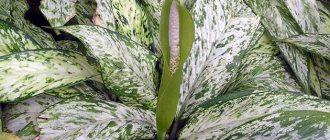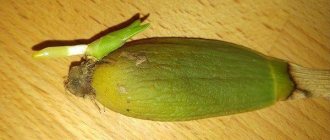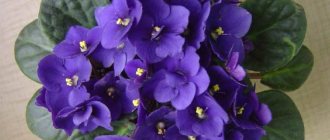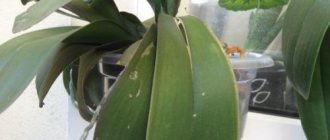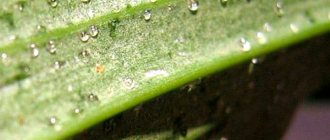What is it and what does it look like?
Sometimes, looking at a plant, you will notice that 1-2 lower leaves have turned yellow and are drying out, while the rest still remain richly green and healthy. Why does this happen and what needs to be done to restore the plant to a healthy appearance? In this case, do not panic: a natural process occurs, as a result of which the lower leaves turn yellow and fall off. The orchid sheds its old foliage in this way.
If the leaves of an orchid first lightened, became limp, and then yellow spots began to form on them, or if the leaves began to turn yellow at the base or on one side, and then the stem began to turn black or acquire a yellow or brown color, this is a sign that there were the rules for caring for the plant have been violated or the plant has become ill.
Photo of the affected flower
Here you can see what an orchid with yellowed leaves looks like:
Why do the lower leaves of an orchid turn yellow?
Also check out these articles
- Tips for choosing a mini tractor
- Kuibyshev breed of sheep
- Winter varieties of apple trees
- Description and characteristics of the Molodezhnaya cherry variety
Aging is one of the most common reasons why orchid leaves turn yellow. This fact is rarely considered by novice gardeners; they immediately begin to suspect disease, improper care, or unsuitable conditions for growth. And yet, although the orchid is a persistent crop, it can also age. Over time, the leaves turn yellow and fall off so that new, young ones can grow. This is a completely natural process that cannot be prevented or stopped.
Yellowed orchid leaves
Interesting!
Seasonal yellowing and complete loss of foliage can be observed exclusively in the Dendrobium orchid.
It is very easy to determine that the leaves are just getting old - the lower leaves will turn yellow, not the upper ones - only the lower tier! The process lasts a long time, for 2-3 months. So if the lower leaves have turned yellow, but all the rest have a natural color, then the reason is precisely aging. This process is characteristic primarily of the Paphiopedilum and Phalaenopsis species.
What are the reasons?
The main reason for the appearance of yellowness on orchid leaves is a violation of the rules of plant care. The most common causes of yellowing leaves include:
- Bad light. This plant needs bright lighting, but the light should be diffused. If the orchid's leaves begin to turn yellow on only one side or yellow spots appear on the leaves, this means that the plant has received sunburn. If all the leaves turn yellow and become limp, this means that the plant, on the contrary, does not have enough light.
- Incorrect watering. This beautiful flower loves regular watering. But sometimes, if this condition is met, you may notice that the foliage begins to turn a little yellow. This means that the plant has been flooded. This happens when the pot for the plant is too small, and the excess moisture simply does not have time to escape. Also, the cause of yellowing of the leaves may be a violation of the level of air humidity in winter.
- Bacterial or fungal infection. If a flower is affected by this disease, yellowness is visible not only on all leaves, but also on the stem. Another sign of this disease is the high rate of spread of yellowness. In such a situation, it is almost impossible to save the plant.
- Violation of transplant rules. If the flower is not replanted in time, the overgrown measles system no longer fits in the pot and becomes deformed, and yellow spots appear on the leaves.
- Potassium deficiency. This leads to the fact that a biochemical process begins to occur in the plant, including the redistribution of potassium from old tissues to new ones, as a result of which mature leaves turn yellow and die.
- Lack of iron in the soil substrate. This can be caused either by an initially incorrectly selected soil mixture when planting the plant, or by watering with low-quality tap water.
- Lack of nitrogen in the substrate. In this case, the leaves turn yellow but do not fall off.
- Chemical burn. This happens when the soil is fertilized excessively, when a concentrate that is too saturated is used when watering.
- Unscrupulous seller. As you know, the larger the specimen, the more expensive its price. Therefore, many sellers use various stimulants to accelerate plant growth. Therefore, situations sometimes arise when, 1-2 years after purchase, the leaves turn yellow at the base, stop growing and fall off. This is a sign that the seller has gone too far with stimulants.
Which inclusions are dangerous and which are not?
Not all changes in leaf color are dangerous to the life of the plant. However, only a specialist botanist can say for sure which inclusions on the foliage are dangerous and which are not. Inconspicuous or unnoticeable spots on the leaves most often do not pose any threat to the plant and may be a seasonal phenomenon or signal minor sunburn.
To determine how severe the yellowing is, it is worth monitoring the condition of the foliage. If they do not grow, do not change in color and shape, and quickly disappear, they do not pose a danger to phalaenopsis.
When should you worry?
As noted above, orchid leaves may turn yellow at the base or completely and fall off due to natural reasons.
Attention! If, in addition to yellowness, other symptoms indicating a disease appear, this should cause concern to the grower.
Such symptoms indicating that the plant is sick or the conditions of its maintenance have been violated include:
- The appearance of signs of rot on roots, leaves and stems.
- Weeping spots on leaves and stems.
- Drying.
- Withered leaves.
- The lower tier of leaves or one side of the plant has completely turned yellow.
- The appearance of brown spots on leaves and stems.
Long-term consequences
If measures are not taken in time, the beautiful orchid may stop blooming, dry out, or the process of rotting may begin, which will ultimately lead to the death of the entire plant.
If the cause of yellowing leaves is an infection, then unless appropriate measures are taken, there is a risk of the disease spreading to other plants.
Treatment for yellowing
If it has been noticed that the leaves of an orchid are not turning yellow due to a natural process, in order to save the plant, you need to do the following:
- Analyze the conditions of detention. It is necessary to check whether the flower is exposed to direct sunlight, check the soil for excess or lack of moisture, check whether the root system has grown and whether the pot has become too small for it.
- If it is discovered that the flower is suffering from sunburn, it must be rearranged.
- If the cause is insufficient watering, then you must:
- Check the soil in the pot. It should be moist.
- If the soil is dry, then it is necessary to moisten it with filtered water.
- We decide to observe watering and monitor the condition of the flower.
- If the cause is excessive watering, then you must:
- Remove the plant from the pot and clean it of the substrate.
- Check the root system for rot.
- If rotten areas are found on the roots, they must be cut off with a sharp blade disinfected in a solution of potassium permanganate. Sprinkle the cut areas with charcoal.
- Replant the orchid in a new pot.
- If the cause is a lack of potassium, nitrogen and iron, then it is necessary to apply fertilizer containing the necessary substances. Introduce fertilizers gradually, monitor changes in the condition of the flower (there are improvements or nothing changes).
Next, we will tell you what to do if the leaves of the plant turn yellow and fall off.
Effect of fertilizers
Timely feeding of the plant in the proportions it needs will bring it many benefits. During vegetative growth, it will help to increase leaf mass and lay a large number of buds. Without fertilizer at home, the flower will have nowhere to get the nutrients it needs to build its cells.
What does overfeeding a plant or lack of minerals lead to?
| microelements | excess | deficit |
| phosphorus | The tip of the leaf turns black. | New shoots grow crooked and in general the plant looks depressed. |
| nitrogen | Rapid growth of green mass begins, the tissues on the sheets crack. It is an easy target for various pests. No or weak flowering. | They look depressed and are covered with yellow spots. Mature leaves die. |
| potassium | The flower does not receive nitrogen and all the ensuing consequences. | Growth stops and tissue softens. |
IMPORTANT! When using fertilizers intended for orchids, do not deviate from the recommendations given on the packaging.
How to save if they lose turgor, turn yellow and fall off?
If the orchid leaves not only begin to turn yellow, but also fall off, then the plant must be urgently revived:
Analyze the conditions of the flower and identify possible causes of the problem.- Change the mode and methods of watering.
- Move the flower pot to another place.
- If the orchid is located next to yucca, peperomia, cordilina or ararkaria, then it is necessary to move them away.
- Replace soil and pot. A new pot must be disinfected with a solution of potassium permanganate before planting.
- Do not use fertilizers or growth stimulants for at least 14 days.
- If fungal or bacterial diseases are detected on the orchid, it must be treated with fungicides.
Important! Only soft water should be used for irrigation.
Subsequent care of the plant at home
After the orchid has recovered and its leaves have turned green again, you must begin to follow the rules of care:
- Provide the flower with enough light. The orchid requires a lot of diffused light. Daylight hours should last 10-12 hours.
- Compliance with the temperature regime: during the day it should not be 18-27 degrees above zero, at night – 13-24 degrees.
- Providing a difference in air temperature between day and night is a necessary condition for good orchid flowering.
- Follow the watering schedule. The soil should be moist, but not wet, and even more so, the water should not stagnate in the pot. Water for watering the orchid must be used soft, and its temperature should be 2-3 degrees warmer than the surrounding air.
- Fertilizers must be applied no more than once every 2-3 weeks; be sure to follow the proportions indicated on the package. After transplanting the plant, it is not recommended to apply fertilizers, since the substrate already contains all the necessary substances.
- Monitor the quality of the substrate and the degree of growth of the root system. Replant the plant in time.
Thus, there are a large number of reasons for the appearance of yellowness on leaves, and they are associated both with natural processes and with violation of the rules of care. If the yellowing of the leaves is not caused by natural causes, then the lack of timely surgical intervention can lead to the death of the plant.
We bring to your attention other articles about the yellowing of the orchid, including the stem and peduncle of the plant, as well as about the drying of the roots and yellowing of the leaves.
Prevention
In order for your flower to remain healthy and delight you with its beauty and attractiveness all year round, you must follow simple preventive measures:
- Regular spraying with warm water will help prevent drying out and the appearance of pests.
- Alternate watering through a tray and by immersion in a container of water.
- You should not cut the peduncle after flowering; you need to wait until it dries completely.
- When replanting a flower, it is better to use a purchased substrate - it does not contain pathogenic microflora and is enriched with all the necessary microelements.
- To avoid drying out the surface of the earthen coma, cover it with a small layer of sphagnum moss.
- It cannot be replanted during the budding and flowering phase, so as not to destroy it.
- An orchid that is fading should be moved to a cooler room, reduce watering and provide moderate humidity. In such conditions, it will fully survive the dormant stage without loss of decorativeness.
